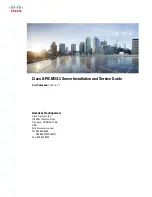
viii
Intel Server Compute Blade SBX82 Installation and User’s Guide
Handling electrostatic discharge-sensitive devices
Any computer part containing transistors or integrated circuits (IC) should be considered sensitive to
electrostatic discharge (ESD). ESD damage can occur when there is a difference in charge between
objects. Protect against ESD damage by equalizing the charge so that the server, the part, the work
mat, and the person handling the part are all at the same charge.
✏
NOTE
Use product-specific ESD procedures when they exceed the requirements noted here.
Make sure that the ESD-protective devices you use have been certified (ISO 9000) as fully effective.
When handling ESD-sensitive parts:
•
Keep the parts in protective packages until they are inserted into the product.
•
Avoid contact with other people.
•
Wear a grounded wrist strap against your skin to eliminate static on your body.
•
Prevent the part from touching your clothing. Most clothing is insulative and retains a charge
even when you are wearing a wrist strap.
•
Use the black side of a grounded work mat to provide a static-free work surface. The mat is
especially useful when handling ESD-sensitive devices.
•
Select a grounding system, such as those in the following list, to provide protection that meets
the specific service requirement.
— Attach the ESD ground clip to any frame ground, ground braid, or green-wire ground.
— Use an ESD common ground or reference point when working on a double-insulated or
battery-operated system. You can use coax or connector-outside shells on these systems.
— Use the round ground-prong of the AC plug on AC-operated computers.
✏
NOTE
The use of a grounding system is desirable but not required to protect against ESD
damage.
DANGER
Electrical current from power, telephone and communication cables is hazardous.
To avoid a shock hazard:
•
Do not connect or disconnect any cables or perform installation, maintenance, or reconfiguration of this
product during an electrical storm.
•
Connect all power cords to a properly wired and grounded electrical outlet.
•
Connect to properly wired outlets any equipment that will be attached to this product.
•
When possible, use one hand only to connect or disconnect signal cables.
•
Never turn on any equipment when there is evidence of fire, water, or structural damage.
•
Disconnect the attached power cords, telecommunications systems, networks, and modems before you
open the device covers, unless instructed otherwise in the installation and configuration procedures.
•
Connect and disconnect cables as described in the following table when installing, moving, or opening
covers on this product or attached devices.









































